Glen Neath, cofounder of Darkfield is no stranger to revolutionary theatre, having worked with his partner David Rosenberg on ‘Shunt’ in 1988, the theatre company who pioneered the art form that has come to be known as immersive theatre. We spoke to Glen about the company, it’s latest production and why darkness creates such a compelling theatre setting.
How did you start engaging in interactive experiences?
I’ve been working with David Rosenberg since 2011 or so, which is when we started talking about making shows using binaural sound in complete darkness. David had already used binaural sound in some of his crossover dance pieces, but the darkness was the new element.
Ultimately we wanted to make each performance feel as if it was related to every single person in the audience. It was trying to put the audience member into the pit as the protagonist. So rather than looking at the show and engaging with it — the idea was they were in the show.
How did you come to develop Darkfield?
Darkfield came from two previous shows that toured quite extensively. There was a certain disparity between the actual sounding of the show, because it was recorded in the particular space. If you then presented it in a space that was radically different, then to the discerning ear there was a shift. You could tell that the recording wasn’t live, and we wanted to always make people feel as if we’re not sure of what was happening in the space around them. We were always playing with this idea of what’s happening and what isn’t — is it real, is it not real? All of the shows have that element.
We couldn’t find a venue to match the recording, so we thought it would be great if we could have our own venue. We decided on the idea of the touring container. We wanted to have a go-to venue, as opposed to people travelling to see a 20 minute show, which was more difficult.
How did you decide that fear and anxiety were the emotions you wanted to explore? Do audience members react differently to the performances you create?
We didn’t want people to be freaked out – it was a very new thing when we started with the first show, “Ring”. We were very aware that we didn’t know how people would react to being in the dark for such a long period of time. We tried to use a friendly voice in the first recordings to make people feel comfortable. There were so many different reactions because some people were just terrified of being in the dark whereas some people found it very relaxing and quite enjoyed it.
We then introduced a second recording with a slightly menacing voice, and this was an element worth playing with. The container idea also allowed us to manipulate the space as well. Previously people were just sitting on a chair, whereas now we’re able to completely control and manipulate the environment.
What can you tell us about the Flight experience?
It’s hard to say much without describing what it is. Just as Séance riffed on what inspired it (and obviously the reason we called it Séance), Flight also explores, on a very experiential level, being on an airplane. There’s something quite exciting about entering a white shipping container and you’re in a new world. The set is designed as a very convincing airplane cabin and inside, the audience can store their bags in overhead lockers. Much like Séance, the general set up is the same – headphones, binaural sound and darkness. However the premise of course is new. The premise always informs the narrative, the narrative isn’t the starting point in any of these presentations.
What’s next for Darkfield?
We will continue to make other shows outside of Darkfield, but for the Darkfield project we envisioned a collection of three shows to begin with. [Also having] a bar in a container and possibly an educational container. We are talking about having a workshop where we invite college students or fellow artists to come in and try out over the course of a few days. That’s what we’re working towards now.




